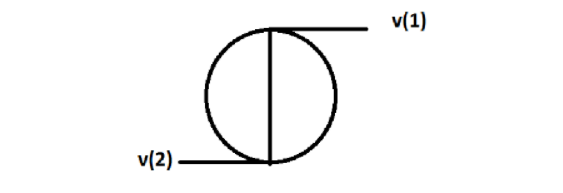Answer
396.9k+ views
Hint:Velocity is a vector quantity while speed is a scalar quantity. Speed gives the magnitude of the velocity, and is not necessary that speed and velocity are equal. In the above case, when the aeroplane moves half the circle, its speed remains the same but the direction of velocity is in the opposite direction.
Complete step by step answer:A particular quantity can be categorized into two types; one is scalar while the other is vector. Scalar quantities have magnitude but they do not have direction, for example distance or temperature. Vector quantities are the quantities that have magnitude as well as direction, such as displacement or acceleration. Velocity is a vector quantity.

It is given that the aeroplane is moving at a uniform speed of 100km/h. Let its velocity be at a directional vector of\[{v_1} = 100\hat i\]. Thus, when it rotates half circle, the direction of velocity, which is always perpendicular, that is tangential to the circle, would be in the opposite direction.
Thus, velocity when the aeroplane rotates half circle would\[{v_2}\]such that\[{v_2} = - 100\hat i\]
Now, the relative velocity of a particle is its final velocity minus the initial=al velocity of the particle. Hence the change in velocity would be as follows:
\[
\Delta v = {v_2} - {v_1} \\
\Delta v = - 100 - 100 \\
\Delta v = - 200\hat i\dfrac{{km}}{h} \\
\]
Thus the change in velocity is 200km/h.
Thus, option (C) is the correct answer.
Notes:Here, we are assuming that the aeroplane is constantly flying along the circumference of the circle and this can only happen when the centripetal force and the gravitational force are cancelling each other out and hence the Newton’s third law of motion is satisfied. Also, here we neglect the force due to air resistance.
Complete step by step answer:A particular quantity can be categorized into two types; one is scalar while the other is vector. Scalar quantities have magnitude but they do not have direction, for example distance or temperature. Vector quantities are the quantities that have magnitude as well as direction, such as displacement or acceleration. Velocity is a vector quantity.

It is given that the aeroplane is moving at a uniform speed of 100km/h. Let its velocity be at a directional vector of\[{v_1} = 100\hat i\]. Thus, when it rotates half circle, the direction of velocity, which is always perpendicular, that is tangential to the circle, would be in the opposite direction.
Thus, velocity when the aeroplane rotates half circle would\[{v_2}\]such that\[{v_2} = - 100\hat i\]
Now, the relative velocity of a particle is its final velocity minus the initial=al velocity of the particle. Hence the change in velocity would be as follows:
\[
\Delta v = {v_2} - {v_1} \\
\Delta v = - 100 - 100 \\
\Delta v = - 200\hat i\dfrac{{km}}{h} \\
\]
Thus the change in velocity is 200km/h.
Thus, option (C) is the correct answer.
Notes:Here, we are assuming that the aeroplane is constantly flying along the circumference of the circle and this can only happen when the centripetal force and the gravitational force are cancelling each other out and hence the Newton’s third law of motion is satisfied. Also, here we neglect the force due to air resistance.
Recently Updated Pages
How many sigma and pi bonds are present in HCequiv class 11 chemistry CBSE

Why Are Noble Gases NonReactive class 11 chemistry CBSE

Let X and Y be the sets of all positive divisors of class 11 maths CBSE

Let x and y be 2 real numbers which satisfy the equations class 11 maths CBSE

Let x 4log 2sqrt 9k 1 + 7 and y dfrac132log 2sqrt5 class 11 maths CBSE

Let x22ax+b20 and x22bx+a20 be two equations Then the class 11 maths CBSE

Trending doubts
Fill the blanks with the suitable prepositions 1 The class 9 english CBSE

At which age domestication of animals started A Neolithic class 11 social science CBSE

Which are the Top 10 Largest Countries of the World?

Give 10 examples for herbs , shrubs , climbers , creepers

Difference between Prokaryotic cell and Eukaryotic class 11 biology CBSE

Difference Between Plant Cell and Animal Cell

Write a letter to the principal requesting him to grant class 10 english CBSE

Change the following sentences into negative and interrogative class 10 english CBSE

Fill in the blanks A 1 lakh ten thousand B 1 million class 9 maths CBSE



